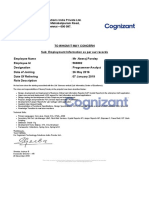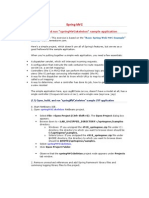Simple Hello World Example Tutorial
Uploaded by
Remix MixdoxSimple Hello World Example Tutorial
Uploaded by
Remix MixdoxSimple Hello World Example Tutorial
Today, where spring can be found as ultimate solution in java world for not only in web
applications but almost every aspect in IT industry. We have discussed a number of
topics under spring tutorial series. Spring has launched its latest version as Spring 4 ,I
was going through the new release and found it very useful and a advancement of
spring.
I downloaded the new release that is not yet finalized till the blog is being published. I
have created a simple hello world application using spring 4 mvc. In this particular blog
i will explain you guys how to create a simple helloworld application in spring using
spring 4 libraries.
Project Structure
Before we start adding some controller code lets first take a look at overall project
structure in eclipse. Here one thing to note down is that we never needs to add all jar
files in spring distribution. I have added only necessary jars here.
Now i will explain you step by step configuration and class files importance.
WebContent\ WEB-I NF\ web.xml
Every web project in java starts with an web.xml file, this is an entry point for
application. As we starts the application or deploy the application on server the
container searches for an web.xml file and work according to configurations.
There is nothing new in spring 4.0 regarding web.xml file, we need to register the
DispatcherServlet here to tell the container that all other upcoming requests are going
to be handled by spring itself. From now whenever a request will come to container it
will delegate the control to spring configuration file to be processed accordingly.
<?xml version="1.0" encoding="UTF-8"?>
<web-app xmlns:xsi="http://www.w3.org/2001/XMLSchema-instance"
xmlns="http://java.sun.com/xml/ns/javaee" xmlns:web="http://java.sun.com/xml/ns/javaee/web-
app_2_5.xsd"
xsi:schemaLocation="http://java.sun.com/xml/ns/javaee http://java.sun.com/xml/ns/javaee/web-
app_2_5.xsd"
id="WebApp_I D" version="2.5">
<display-name>Spring4MVC</display-name>
<welcome-file-list>
<welcome-file>index.jsp</welcome-file>
</welcome-file-list>
<servlet>
<servlet-name>spring</servlet-name>
<servlet-class>org.springframework.web.servlet.DispatcherServlet</servlet-class>
<load-on-startup>1</load-on-startup>
</servlet>
<servlet-mapping>
<servlet-name>spring</servlet-name>
<url-pattern>*.html</url-pattern>
</servlet-mapping>
</web-app>
WebContent\ index.jsp
We have declared an welcome file in web.xml, this is the first file that the user will see
at running project. We have added a simple link here this will call the controller
mappings accordingly.
<html>
<head>
<script type="text/javascript" src="jquery-1.2.6.min.js"></script>
<title>Being J ava Guys | Hello World</title>
</head>
<body>
<center>
<h2>Being J ava Guys | Hello World</h2>
<h4><a href="hello.html">Click Here</a></h4>
</center>
</body>
</html>
WebContent\ WEB-I NF\ spring-servlet.xml
This is core of all spring applications, all configurations related to spring goes here in a
single file. Here one thing to note down is that the container will detect a file as spring
configuration file if the file is ending with '-servlet' suffix. We have defined a base
package over here that helps the application to search appropriate 'url mapping'. Every
requested url will be searched in the controller classes defined under 'base-package'
directory and annotated with '@controller'.
Spring supports a number of view types including, jsp,html,xslt,xml,freemarker ...etc.
We have added a simple view resolved to point our jsp file to be shown as output.
<?xml version="1.0" encoding="UTF-8"?>
<beans xmlns="http://www.springframework.org/schema/beans"
xmlns:xsi="http://www.w3.org/2001/XMLSchema-instance"
xmlns:p="http://www.springframework.org/schema/p"
xmlns:context="http://www.springframework.org/schema/context"
xsi:schemaLocation="http://www.springframework.org/schema/beans
http://www.springframework.org/schema/beans/spring-beans-3.0.xsd
http://www.springframework.org/schema/context
http://www.springframework.org/schema/context/spring-context-3.0.xsd">
<context:component-scan base-package="com.beingjavaguys.controller" />
<bean id="viewResolver"
class="org.springframework.web.servlet.view.InternalResourceViewResolver">
<property name="prefix">
<value>/WEB-I NF/pages/</value>
</property>
<property name="suffix">
<value>.jsp</value>
</property>
</bean>
</beans>
src\ com\ beingjavaguys\ controller\ HomeControlle
r.java
This is a simple controller class for our application, to make a class work as controller
we need to add a '@Controller' annotation. To match the appropriate url with controller
method add a '@RequestMapping' annotation there enclosed within double cotes.
package com.beingjavaguys.controller;
import org.springframework.stereotype.Controller;
import org.springframework.web.bind.annotation.RequestMapping;
import org.springframework.web.servlet.ModelAndView;
@Controller
public class HomeController {
@RequestMapping("/hello")
public ModelAndView test() {
String message = "Welcome to Spring 4.0 !";
return new ModelAndView("hello", "message", message);
}
}
WebContent\ WEB-I NF\ pages\ hello.jsp
This is nothing but a simple jsp file, once the request is completed the control is moved
to a jsp file.
<html>
<head>
<script type="text/javascript" src="jquery-1.2.6.min.js"></script>
<title>Being J ava Guys | Hello World</title>
</head>
<body>
<center>
<h2>Being J ava Guys | Hello World</h2>
<h4>${message}</h4>
</center>
</body>
</html>
Data flow of Spring MVC web application.
As the request comes to container it goes to web.xml, we have added a spring entry
there this pushes the request to spring-servlet. Here the base package is read by the
container and it searches all java classes with '@Controller' annotation in the package.
Than an appropriate method is being called having same url as the requested one.
Code written in method is executed line by line and an output is generated and showed
on browsed as per the view resolver configuration.
In this particular blog we cam across 'Spring hello world application' and a detailed
explanation to each and every configuration file in the project setup. In upcoming blogs
we will cover other topics related to spring and other technologies.
Thanks for reading !
You might also like
- Getting started with Spring Framework: A Hands-on Guide to Begin Developing Applications Using Spring FrameworkFrom EverandGetting started with Spring Framework: A Hands-on Guide to Begin Developing Applications Using Spring Framework4.5/5 (2)
- Core Spring 3.0 Certification Mock Exam: ContainerNo ratings yetCore Spring 3.0 Certification Mock Exam: Container10 pages
- Firebase Storage for Angular: A reliable file upload solution for your applicationsFrom EverandFirebase Storage for Angular: A reliable file upload solution for your applicationsNo ratings yet
- Spring Boot Intermediate Microservices: Resilient Microservices with Spring Boot 2 and Spring CloudFrom EverandSpring Boot Intermediate Microservices: Resilient Microservices with Spring Boot 2 and Spring CloudNo ratings yet
- Data Insert/Update Using RESTFul Web Service (Hibernate + Spring + Maven)No ratings yetData Insert/Update Using RESTFul Web Service (Hibernate + Spring + Maven)15 pages
- An Introduction To The Spring M.V.C. FrameworkNo ratings yetAn Introduction To The Spring M.V.C. Framework35 pages
- Spring Boot and Single-Page Applications: Securing Your API with a Single-Page Application Frontend - Second EditionFrom EverandSpring Boot and Single-Page Applications: Securing Your API with a Single-Page Application Frontend - Second EditionNo ratings yet
- HNVN TR 07040 SpringWebMVC Part1 CoursePresentationNo ratings yetHNVN TR 07040 SpringWebMVC Part1 CoursePresentation37 pages
- JAVASCRIPT FRONT END PROGRAMMING: Crafting Dynamic and Interactive User Interfaces with JavaScript (2024 Guide for Beginners)From EverandJAVASCRIPT FRONT END PROGRAMMING: Crafting Dynamic and Interactive User Interfaces with JavaScript (2024 Guide for Beginners)No ratings yet
- Getting Started with Oracle WebLogic Server 12c: Developer’s GuideFrom EverandGetting Started with Oracle WebLogic Server 12c: Developer’s GuideNo ratings yet
- Mastering Node.js Web Development: Go on a comprehensive journey from the fundamentals to advanced web development with Node.jsFrom EverandMastering Node.js Web Development: Go on a comprehensive journey from the fundamentals to advanced web development with Node.jsNo ratings yet
- MVC Spring Application Setup:: DependenciesNo ratings yetMVC Spring Application Setup:: Dependencies9 pages
- Create Spring MVC Project On The Eclipse, Create A Spring MVC ProjectNo ratings yetCreate Spring MVC Project On The Eclipse, Create A Spring MVC Project7 pages
- Java Spring Framework Mastery: Advanced Techniques and Best PracticesFrom EverandJava Spring Framework Mastery: Advanced Techniques and Best PracticesNo ratings yet
- Django Unleashed: Building Web Applications with Python's FrameworkFrom EverandDjango Unleashed: Building Web Applications with Python's FrameworkNo ratings yet
- Building Web Apps in Java: Servlet: A Servlet's JobNo ratings yetBuilding Web Apps in Java: Servlet: A Servlet's Job10 pages
- JavaScript File Handling from Scratch: A Practical Guide with ExamplesFrom EverandJavaScript File Handling from Scratch: A Practical Guide with ExamplesNo ratings yet
- Building Web Applications With Spring 3.0: by Bob Mccune100% (3)Building Web Applications With Spring 3.0: by Bob Mccune45 pages
- Spring Framework Notes For ProfessionalsNo ratings yetSpring Framework Notes For Professionals67 pages
- Full download (Ebook) Pro Spring MVC with WebFlux: Web Development in Spring Framework 5 and Spring Boot 2 - Second Edition by Marten Deinum; Iuliana Cosmina ISBN 9781484256657, 1484256654 pdf docx100% (9)Full download (Ebook) Pro Spring MVC with WebFlux: Web Development in Spring Framework 5 and Spring Boot 2 - Second Edition by Marten Deinum; Iuliana Cosmina ISBN 9781484256657, 1484256654 pdf docx55 pages
- Introduction To Spring Framework: by Shailesh PawarNo ratings yetIntroduction To Spring Framework: by Shailesh Pawar21 pages
- APM For Java. AppDynamics Pro Documentation. Version 4.0.x. Page 1No ratings yetAPM For Java. AppDynamics Pro Documentation. Version 4.0.x. Page 1196 pages
- The Comparison of Microservice and Monolithic ArchitectureNo ratings yetThe Comparison of Microservice and Monolithic Architecture4 pages
- Java 2: Senior Systems Analyst/Software EngineerNo ratings yetJava 2: Senior Systems Analyst/Software Engineer3 pages

























































































